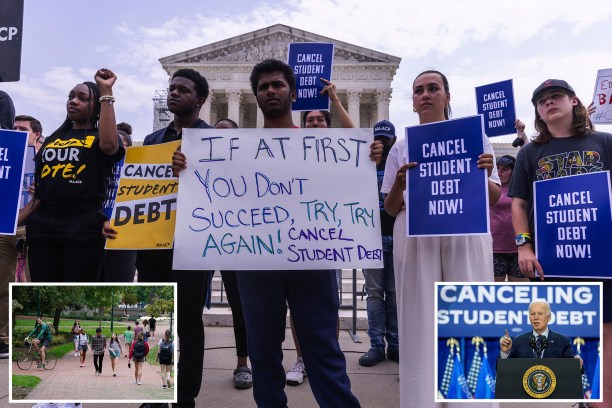Lame-Duck Biden Unilaterally Moves to Cancel Another $147B in Student Debt; New Guidance On Latest Student Loan Forgiveness Plan Issued Prior To Key August Deadline
Lame-duck Biden unilaterally moves to cancel another $147B in student debt:
Lame-duck President Biden is pushing forward with his election-year bid to cancel outstanding federal student debt, with his Education Department announcing Wednesday at least $147 billion in potential loan forgiveness for 23 million student borrowers over the next decade.
As part of a proposed rule, Education Secretary Miguel Cardona could issue waivers for the federal loans, mostly to Pell Grant recipients, as soon as September — less than two months before Election Day 2024. If finalized, the rule would immediately cancel up to $132 billion in student debt.
The department said it “will begin emailing all borrowers with at least one outstanding federally held student loan to provide updates on potential student debt relief, and to inform them they have until August 30 to call their servicer and opt out if they do not want this relief,” according to a press release.
“The rules that would provide this relief are not yet finalized, and the email does not guarantee specific borrowers will be eligible,” it added, noting that so far, 4.8 million students borrowers have had a collective $168 billion in debt canceled.
That includes $69.2 billion for 946,000 borrowers through fixes to Public Service Loan Forgiveness (PSLF); $51 billion for more than 1 million borrowers with income-driven repayment plans; $28.7 billion for more than 1.6 million borrowers whose institutions shuttered or were sued and part of settlements; $14.1 billion for more than 548,000 borrowers with either a partial or total disability; and $5.5 billion for 414,000 borrowers through the Saving on A Valuable Education (SAVE) Plan.
Cardona boasted that the forgiveness would “mark the next milestone in our efforts to help millions of borrowers who’ve been buried under a mountain of student loan interest, or who took on debt to pay for college programs that left them worse off financially, those who have been paying their loans for twenty or more years, and many others.”
“Today, the Biden-Harris administration takes another step forward in our drive to deliver student debt relief to borrowers who’ve been failed by a broken system,” he said in a statement. “The Biden-Harris Administration made a commitment to deliver student debt relief to as many borrowers as possible as quickly as possible, and today, as we near the end of a lengthy rule-making process, we’re one step closer to keeping that promise.” —>READ MORE HERE
New Guidance On Latest Student Loan Forgiveness Plan Issued Prior To Key August Deadline:
The Biden administration has released new details on an upcoming student loan forgiveness initiative that could benefit millions of borrowers.
The latest plan, expected to launch this fall, is intended as a second attempt at mass student debt relief after President Joe Biden’s first plan was struck down by the Supreme Court last year. Following nearly a year of negotiated rulemaking (an administrative process to develop new regulations), the Education Department has indicated that the new program is in its final stages.
In conjunction with millions of notices that officials sent out to borrowers last week with an important opt-out deadline, the department has updated its official guidance on the plan. The new details provide additional clarity on the four categories of borrowers that may be eligible for loan forgiveness, even while the department continues to work on finalizing the rules for the program. A fifth category based on hardship is not expected to launch until sometime next year.
Here’s a breakdown.
Student Loan Forgiveness For Runaway Interest Accrual
One of the primary groups of borrowers potentially eligible for student loan forgiveness under Biden’s new plan are those who have experienced an increase in their loan balance over time due to interest accrual and capitalization. This can occur under a variety of circumstances, such as being in an income-driven repayment plan when the payments are less than the monthly amount of interest accrual. In that scenario, a borrower could make substantial payments over a long period of time, and still wind up owing more than what they originally borrowed.
According to the new Education Department guidance, a borrower is eligible for partial student loan forgiveness under this category if their “current balance on an unconsolidated Direct Loan, ED-held Federal Family Education Loan (FFEL) Program loan, or ED-held Perkins loan is greater than the balance of that loan when it entered repayment,” or if the “current balance on a consolidation loan is greater than the balance of the loans included in your consolidation loan when the original loans entered repayment.”
“All borrowers would be eligible for this debt cancellation, either up to the amount by which the borrower’s current balance exceeds the principal and interest balance when the loans entered repayment or $20,000, whichever is less,” says the department. But borrowers who are enrolled in an IDR plan and earn $120,000 or less per year individually or as married filing separately, or $240,000 or less per year as married filing jointly, could receive student loan forgiveness for “all principal and interest above the principal and interest balance at the time their federal student loans entered repayment.”
Student Loan Forgiveness For Those Who First Entered Repayment Many Years Ago —>READ MORE HERE







Comments are closed.